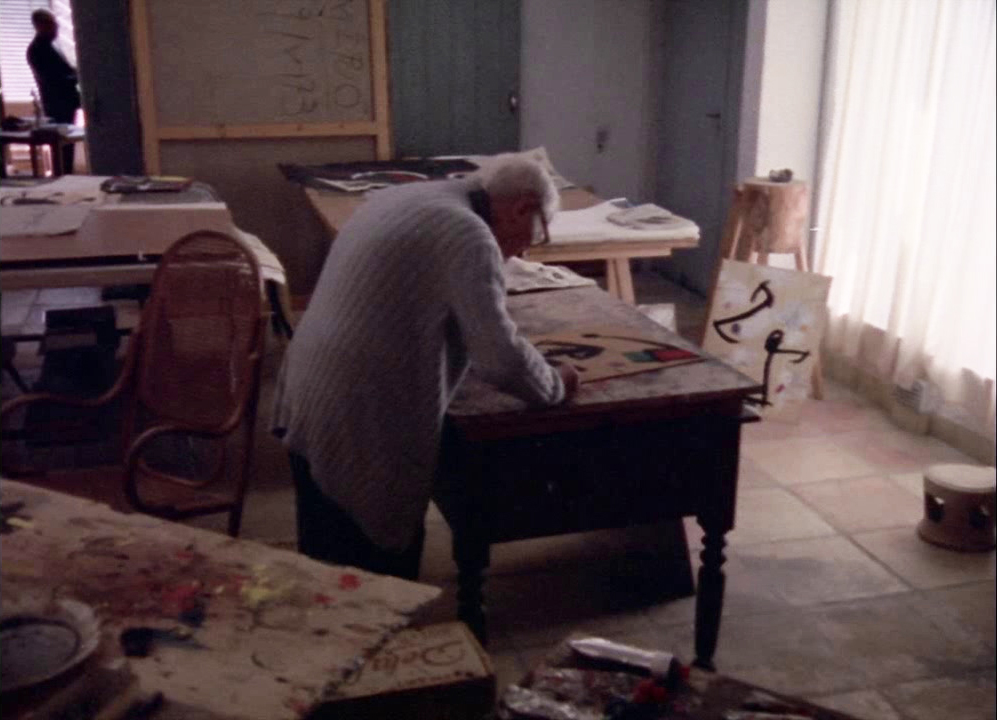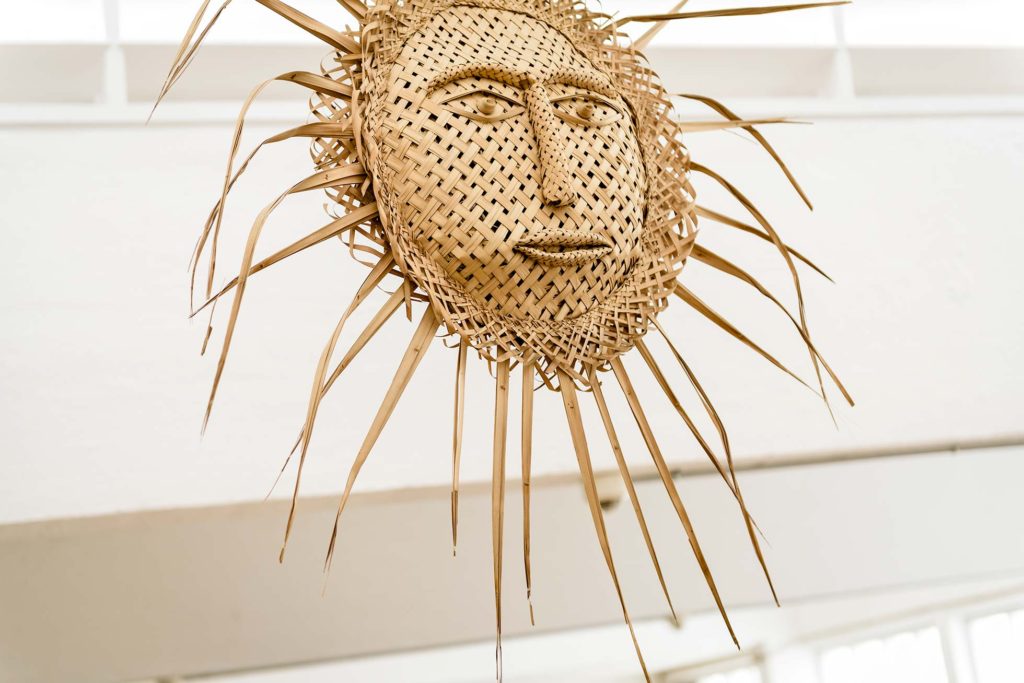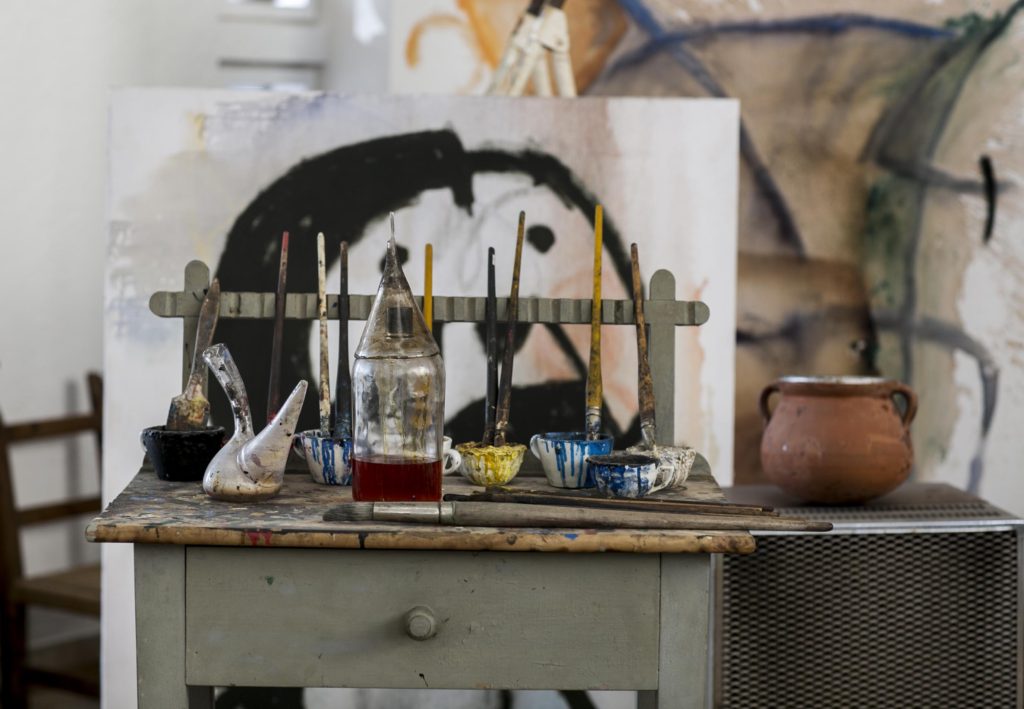After years of incessant travel, in 1956, Joan Miró settled down in Mallorca, an island he had visited ever since he was a small child. It was at this point that Miró was able to have the studio of his dreams, the Sert Studio.
The studio was designed by Josep Lluís Sert, a prestigious architect and friend of Miró’s, representative of the modern architectural movement and Dean of Harvard University’s Graduate School of Design at the time. Sert had been disqualified from working as an architect in Spain for 20 years, and so the studio marked a turning point in his career.
Sert designed a building that fitted in with the terrain’s hillside terraces. Miró helped him with practical aspects, suggesting that he bear in mind Mallorca’s climate and the studio’s atmospheric conditions. He asked Sert to make sure that the work and storage areas were clearly separated so that he could keep his distance from any canvases that had been left to rest. He also reminded Sert to take into account the dimensions of large paintings, like his Cincinnati mural, in the design of the work area. In the autumn of 1956, the studio by Sert was completed and Miró was delighted with the outcome.


Josep Lluís Sert“Architecture itself can become a sculpture”
Through numerous plans and sketches, Sert had designed a life-size studio where tradition was combined with innovation. The concrete structure contrasts with more traditional Mediterranean materials, like stone or clay. The L-shaped studio is on two levels, with a vaulted roof. The undulating roof gives the building’s regular-shaped structure a sinuous sense of movement. A plastic approach was taken to all the façades, with attention to colour, especially the south façade, where the white concrete is juxtaposed with blue or terracotta and also with the red and yellow of the woodwork.
In short, Sert invented a whole new language that overcame the rigidity and limitations of more orthodox functionalism and he sought a more plastic, sculptural approach to architecture in keeping with his notion that “Architecture itself can become a sculpture.”[1].


In order to create an atmosphere that would inspire creativity, Miró gradually filled his studio with a wide assortment of bits and bobs that coexisted in perfect harmony with the tools of his trade.
Even today that same creative backdrop has been conserved and the canvases, oils, watercolours, crayons, paint brushes and other brushes and sponges continue to live in perfect harmony with his “collection” of widely assorted objects, including postcards, newspaper cuttings, natural finds like stones, butterflies or shells, objects from popular Mediterranean culture such as siurells (clay whistles), Palm Sunday palm leaves and figures from nativity cribs, and items associated with far-distant cultures, like Hopi Indian kachina dolls or Oceanic masks.
The Sert Studio is one of Mallorca’s emblematic buildings and it has been declared an Item of Cultural Heritage (BIC according to its Spanish acronym).
Miró – Sert, the construction of a friendship
Miró and Sert met in the early 1930s and long-lasting prosperous personal and professional ties were gradually forged, based on common concerns, in particular their desire to integrate art with architecture and their interest in simplicity as a means of capturing the very essence of things [1]. This is highlighted by the way in which Miró’s works of art blend harmoniously into the architecture of the Sert Studio.
In Barcelona, Miró took part in the birth of avant-garde movements, sharing ideas and projects with ADLAN (Friends of New Art) and GATCPAC (Group of Catalan Architects and Technicians for the Progress of Contemporary Architecture). The artist found like-minded people and ideas among their members, particularly in the case of Joan Prats and Josep Lluís Sert. Architects and artists upheld the principles of rationalism and a belief in architecture’s social function.[2].
In 1937, Sert and Luís Lacasa designed the Spanish Republic’s pavilion for the Paris International Expo. This had strong political connotations and it was the perfect opportunity to put into practice that longed for desire to integrate architecture with the plastic arts. Miró painted a large oil for it, Catalan Peasant in Revolt (The Reaper).


At the end of the Spanish Civil War, with the Franco dictatorship, Sert was forced to seek exile in the United States. As a result, Sert and Miró exchanged ideas on the design of the artist’s studio by post. During the construction of the Sert Studio (1954-1956), there was intense correspondence between them and the letters bear witness to the architectural ideas that were achieved and to how the work was progressing. This correspondence made up for the architect’s presence on site and the work was supervised by architect Enric Juncosa, Miró’s brother-in-law.
The studio is the outcome of carefully matured ideas in which Sert managed to achieve a perfect mix of the building’s adaptation to the geographical setting, to local tradition and to the spirit of Miró. The studio represented a breath of fresh air for the modern architecture of the day, in a strong well-defined language all of its own, and it is considered to be the origin of Sert’s subsequent architectural work.
[1] Josep Maria Rovira, José Luis Sert, 1901-1983, Milano: Electa, 2000, page, 251.
[2] AC. Documentos de Actividad Contemporánea. GATEPAC. {Barcelona. Madrid. San Sebastian}, issue no. 18. Year V, 2nd quarter of 1935. AC, a journal specializing in popular architecture and craftwork, sheds light on this subject because it sums up the beliefs shared by Miró and Sert.
[3] Fundació Pilar i Joan Miró a Mallorca. Miró Sert. La construcció d’una amistat. 2007.















